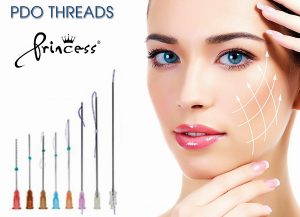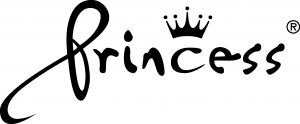
PDO Thread Lift
Thread lifts are the non-surgical cosmetic alternative to the traditional ‘surgical facelift’ that typically involves making incisions around the ear and hairline with a scalpel and tightening/trimming the skin of the face with a scalpel to ‘lift’ it into place. A surgical facelift involves regional or often a general anaesthetic and a recovery period while the tissues heal – this also comes with the risk of infection and poor outcome. Most people opt to choose Thread Lift as they can achieve dramatic results when inserted by trained professionals, and carry only minimal requirement for rest and recuperation post-treatment, if any at all.
There are different kinds of threads which may be used to lift any part of the face, including the forehead, cheeks, jowls, jawline and neck. The two main types are made of either Poly L lactic acid (PLA) or polydioxanone (PDO) also caprolactone. Both PLA and PDO have collagen stimulating properties and are resorbable (dissolve over time leaving tighter ‘scar’ maybe use ‘repair’ tissue instead as they often produce Type 3 Collagen tissue behind to prolong the result.) The threads are either smooth (monos) for improving skin texture or consist of barbs, cogs, anchors or screws to reposition the tissue.
Your PDO thread clinician will have been thoroughly trained in facial anatomy and will be able to assess where best to place the threads to create optimal lift using vectors and an understanding of how the tissues of the face move together.
You should only ever consider having threads inserted by a fully-qualified clinician, and Athena Group Practitioners welcome and are happy to answer any of your questions.
–
Please use the More Information and FAQ tabs below to find out more.

+ More information
How does it work?
A typical treatment involves placement of the desired number of threads, which may range from a single thread per side but can involve 50 threads or more to treat the face and neck. Various entry points are considered depending on the individual face shape and requirements. Local anaesthetic may be injected to make the procedure as pain free as possible. The threads are introduced with a needle or a blunt ended cannula which is removed once the threads have been positioned. Threads which are used to reposition the skin will have the ends protruding after insertion and they are trimmed to below the level of the skin once the desired lift has been achieved. Smooth threads are anchored to lift and stimulate collagen.
What is it used to treat?
- Brow lift
- Sagging cheeks
- Nose to mouth folds
- Jaw line
- Neck
Results
You can expect an immediate lift to the treated area, but this will always relax somewhat once the initial swelling has settled down. Appearance is expected to gradually improve over a period of 2-3 months as collagen remodeling occurs.
Am I suitable for treatment?
The practitioner will take a detailed medical history to ensure you have no conditions that might increase risk of unwanted side effects, consultation is also important to discuss your expectations and whether or not this treatment is able to meet them.
This treatment is most suitable for those between the ages of 35 and 65 with moderate’ sagging’ or skin laxity. Surgery options or combined treatments will be recommended to some patients to ensure expectations can be met.
Is it safe?
Thread lifting is safe, but not entirely risk free, the practitioner will discuss all the risks and benefits with you at consultation and again prior to treatment.
Does it Hurt?
A local anaesthetic may be is injected to make the procedure as comfortable as possible, but some patients will find this procedure painful and some tenderness after the anaesthetic has worn off is to be expected.
Before treatment…
All make up will need to be removed prior to treatment, so please come ‘fresh faced’ if possible. We are happy to remove your make-up for you prior to treatment.
Alcohol, aspirin, Ibuprofen and a range of dietary supplements including; St. Johns Wort, fish oils, Gingko Biloba, Vitamins C and E- may all contribute to bruising and are best avoided 24 hours before treatment.
Treatment cannot be administered if there is an active skin infection, including acne or cold sores or if you are unwell- including colds, coughs, sore throats etc. Do contact the clinic to discuss any illness or new medicines prior to attending.
Aftercare Advice
Most people are able to continue with normal activities with immediate improvement in their appearance. Some will have some redness, pin prick marks, and some degree of swelling, possibly some puckering along the site of the suture, possibly, indentations at the insertion or exit points. The immediate side effects are expected to settle within 2 weeks.
For up to a week after the procedure it may feel tender around the sutures. If necessary, you can take some simple paracetamol to help with this although most patients do not bother with this step. You may feel the stitches and the anchoring cones beneath your skin especially when you apply your skincare products or make up, although you should not be able to see them.
You will be advised
- sleep on your back for 5 nights
- Make-up should not be worn for 12 hours
- No facials or facial massage for 10 days
- No extreme facial expressions for 2 weeks
- Application of anti-biotic cream as advised.
- To attend a review appointment as advised.
- to avoid alcohol, vigorous exercise, sun bathing, and extremes of heat or cold for 14 days post treatment. These activities have been found to increase and prolong swelling.
- Swelling may worsen in the first 24 hours, and then should settle within the first few days. Cold packs can be helpful in reducing swelling.
- Bruising may take a few days to appear, arnica can be helpful in clearing bruising. It is advisable to avoid aspirin and alcohol for 12-48 hours after treatment.
- Tenderness should settle as swelling goes down
+ FAQs
Prices
Please send an email enquiry and your practitioner will call you to discuss your requirements. There are many different sizes of threads and prices will depend on what you are looking to achieve and how best your practitioner may be able to treat you based on physical examination findings.

